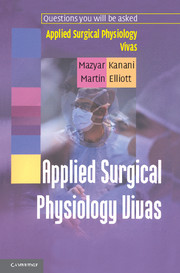Book contents
- Frontmatter
- Contents
- List of Abbreviations
- Dedication
- Preface
- A Change in Posture
- Acid-Base
- Action Potentials
- Adrenal Cortex I
- Adrenal Cortex II – Clinical Disorders
- Adrenal Medulla
- Arterial Pressure
- Autonomic Nervous System (ANS)
- Carbon Dioxide Transport
- Cardiac Cycle
- Cardiac Output (CO)
- Cell Signalling
- Cerebrospinal Fluid (CSF) and Cerebral Blood Flow
- Colon
- Control of Ventilation
- Coronary Circulation
- Fetal Circulation
- Glomerular Filtration and Renal Clearance
- Immobilization
- Liver
- Mechanics of Breathing I – Ventilation
- Mechanics of Breathing II – Respiratory Cycle
- Mechanics of Breathing III – Compliance and Elastance
- Mechanics of Breathing IV – Airway Resistance
- Microcirculation I
- Microcirculation II
- Micturition
- Motor Control
- Muscle I – Skeletal and Smooth Muscle
- Muscle II – Cardiac Muscle
- Nutrition: Basic Concepts
- Pancreas I – Endocrine Functions
- Pancreas II – Exocrine Functions
- Potassium Balance
- Proximal Tubule and Loop of Henle
- Pulmonary Blood Flow
- Renal Blood Flow (RBF)
- Respiratory Function Tests
- Small Intestine
- Sodium Balance
- Sodium and Water Balance
- Starvation
- Stomach I
- Stomach II – Applied Physiology
- Swallowing
- Synapses I – The Neuromuscular Junction (NMJ)
- Synapses II – Muscarinic Pharmacology
- Synapses III – Nicotinic Pharmacology
- Thyroid Gland
- Valsalva Manoeuvre
- Venous Pressure
- Ventilation/Perfusion Relationships
Ventilation/Perfusion Relationships
Published online by Cambridge University Press: 06 January 2010
- Frontmatter
- Contents
- List of Abbreviations
- Dedication
- Preface
- A Change in Posture
- Acid-Base
- Action Potentials
- Adrenal Cortex I
- Adrenal Cortex II – Clinical Disorders
- Adrenal Medulla
- Arterial Pressure
- Autonomic Nervous System (ANS)
- Carbon Dioxide Transport
- Cardiac Cycle
- Cardiac Output (CO)
- Cell Signalling
- Cerebrospinal Fluid (CSF) and Cerebral Blood Flow
- Colon
- Control of Ventilation
- Coronary Circulation
- Fetal Circulation
- Glomerular Filtration and Renal Clearance
- Immobilization
- Liver
- Mechanics of Breathing I – Ventilation
- Mechanics of Breathing II – Respiratory Cycle
- Mechanics of Breathing III – Compliance and Elastance
- Mechanics of Breathing IV – Airway Resistance
- Microcirculation I
- Microcirculation II
- Micturition
- Motor Control
- Muscle I – Skeletal and Smooth Muscle
- Muscle II – Cardiac Muscle
- Nutrition: Basic Concepts
- Pancreas I – Endocrine Functions
- Pancreas II – Exocrine Functions
- Potassium Balance
- Proximal Tubule and Loop of Henle
- Pulmonary Blood Flow
- Renal Blood Flow (RBF)
- Respiratory Function Tests
- Small Intestine
- Sodium Balance
- Sodium and Water Balance
- Starvation
- Stomach I
- Stomach II – Applied Physiology
- Swallowing
- Synapses I – The Neuromuscular Junction (NMJ)
- Synapses II – Muscarinic Pharmacology
- Synapses III – Nicotinic Pharmacology
- Thyroid Gland
- Valsalva Manoeuvre
- Venous Pressure
- Ventilation/Perfusion Relationships
Summary
1. On which factors does adequate blood oxygenation depend on?
Normal ventilation of the lung: this is determined by a normal respiratory drive and a functionally normal respiratory apparatus (includes the brain, chest wall, airways and lung parenchyma)
Adequate diffusion of respiratory gasses across the alveolar wall
Matching of ventilation and perfusion
2. By what process do the respiratory gases pass through the various anatomic barriers to pass into the blood?
Through diffusion.
3. Which physical law determines diffusion across membranes?
Fick's law of diffusion: This states that the amount of gas diffusing per unit time (i.e. the rate of diffusion) is inversely proportional to the thickness of the barrier and directly proportional to the surface area of the barrier.
4. What are the anatomic layers that respiratory gases have to pass through to reach the haemoglobin molecule in the red cells?
The fluid lining the alveoli: gases initially dissolve in this before proceeding to the next layer
Alveolar epithelium and through its basement membrane
Interstitial space: which also contains fluid
Basement membrane of capillary endothelium
Capillary endothelium
Plasma
Red cell membrane
5. What is shunt?
This refers to venous blood that passes to the systemic circulation without first being oxygenated in the lungs.
6. Is this always pathological?
No, under normal circumstances, 1–2% of the CO bypasses the alveoli. This is called the anatomic shunt.
7. Where are the sites for normal anatomic shunt?
The bronchial circulation
Cardiac Thebesian veins: that drain coronary venous blood directly into the left side of the heart
[…]
- Type
- Chapter
- Information
- Applied Surgical Physiology Vivas , pp. 174 - 177Publisher: Cambridge University PressPrint publication year: 2004



